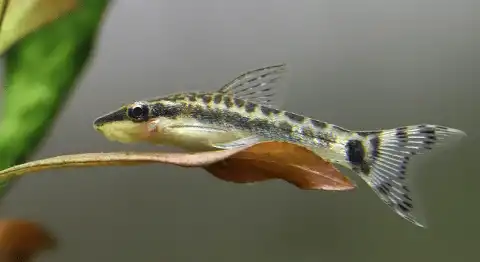Thank you for visiting! By the way… any links on this page that lead to products on Amazon and other stores/partners are affiliate links Aquarium Store Depot earns a commission if you make a purchase.
Are you battling with unsightly algae in your betta tank? Adding an algae-eater or three can be a great natural way to keep this common aquarium headache at bay. However, there’s a lot of thought that goes into selecting the right species for your particular tank.
In this guide, we’ll dive into some of the options that work, and some of the options that don’t. Read along to find the right algae eater for betta tanks!
Key Takeaways
- The best algae eaters for Bettas are mystery snails and Otocinclus catfish
- Some fish are poor choices due to the betta’s aggressive nature or preference for warmer waters
- Make sure to supplement food with your algae eaters as it’s likely for them to starve without it
- Consider live plants if you want a more natural way to combat algae by having them outcompete outbreaks
What Is Algae?
Algae are plant like organisms that grow their food through photosynthesis. There are many types of algae and some of them are much easier to control than others!
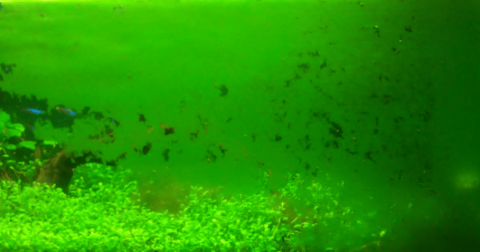
Algae blooms are normal in new tanks that are still going through their first cycle. However, you can expect to see some algae in mature aquariums too.
There are many ways to control algae growth, ranging from manual scrubbing to growing live plants, but adding a few algae eaters is probably the most interesting method!
Increasing maintenance, limiting waste products, fish food, and reducing aquarium light duration are also effective techniques that can help you beat algae.
There’s a lot more to learn about aquarium algae! check out my guide to 10 types of aquarium algae (and how to get rid of them!) for more detailed information.
What You Need to Know About Temperment
Betta fish are known for their aggressive nature, but they don’t always deserve this reputation. Many aquarists keep their bettas with a variety of other fish without any problems, although there are always risks involved.
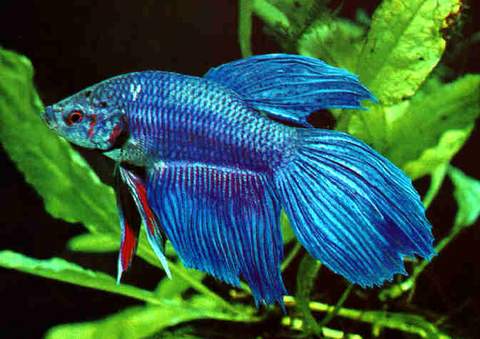
You see, betta fish were originally bred for fighting, so it’s no surprise that many individuals still have a mean streak. Some bettas are just more aggressive than others, and it has a lot to do with their own individual personality.
Tank size matters too, and upgrading to a larger aquarium can help to curb aggressive betta fish behavior. However, you should always have a backup plan in case your betta doesn’t get along with its new algae-busting friends.
Go ahead and check out my guide to the 15 best betta tankmates to learn much more!
Algae Eater For Betta Tank – 7 Top Picks
There are many amazing algae eaters in the aquarium hobby, but these seven species are my top picks for your betta fish aquarium! Check out the video from our YouTube Channel and the additional details below from our blog post!
1. Octocinclus Catfish
A small algae-eating fish. Also great with freshwater shrimp.
- Scientific name: Otocinclus sp.
- Difficulty: Moderate
- Adult size: 1.75 inches
- Minimum tank size: 10 gallons
- Temperature: 70 – 77 °F
- Algae types: Soft green algae and diatoms
Otocinclus catfish are about the smallest algae-eating fish in the hobby. These nano fish are also known as dwarf suckers for their habit of sucking onto aquarium glass, plants, and hardscape features.
Otos are extremely peaceful and make excellent algae eaters for betta tanks, although they are not the ideal choice for beginners or aquarists with small tanks. They can be kept in tanks as small as 10 gallons, although 15 gallons or larger would be better.
If your otocinclus catfish do their job a little too well and eat all the algae in their tank, you’ll need to supplement their diet with algae wafers and some soft greens like zucchini. They are social fish, so pick up a school of five or more.
2. Nerite Snail
Horned Nerite Snails are excellent algae eaters for planted tanks.
- Scientific name: Neritina spp., Vittina spp., Clithon spp.
- Difficulty: Easy
- Adult size: 0.75 – 1 inch
- Minimum tank size: 5 gallons
- Temperature: 70 – 80 °F
- Algae types: Soft green algae, diatoms, green spot algae
Nerite snails are the smallest algae eaters and the number one choice for small betta aquariums in the 5-gallon range. These hard-working mollusks are some of the best-looking inverts in the hobby, and they do a terrific job of cleaning algae in an aquarium.
Nerites breed in brackish water, so there’s no chance of finding any baby snails in your tank. However, they will lay a few eggs here and there. Most betta fish will get along great with nerite snails, but some aggressive fish will nip at nerites.
3. Mystery Snail
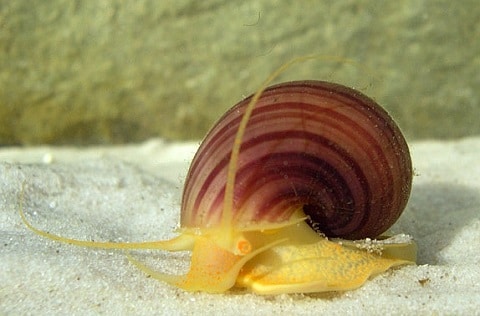
- Scientific name: Pomacea bridgesii
- Difficulty: Easy
- Adult size: 2 inches
- Minimum tank size: 5 gallons
- Temperature: 70 – 80 °F
- Algae types: Various
Mystery snails are large aquarium invertebrates that grow to about the size of a golf ball. They come in a variety of cool colors, making them an interesting display animal for your betta tank.
These snails will eat algae and uneaten food in the tank, so they’re great for keeping your tank clean. However, they are not as good at algae control as their smaller cousin the nerite. If you keep just one, you won’t have to worry about any unsightly eggs, although they can reproduce if you keep two or more.
Other snail species, like rabbit snails and ramshorn snails, are helpful for algae control, although you might want to avoid species like ramshorns and Malaysian trumpet snails if you don’t like the idea of breeding snails in your tank.
4. Bristlenose Pleco
The Bristlenose Pleco is a smaller Pleco that does a great job of eating algae. Peaceful and gets along with most fish
- Scientific name: Ancistrus spp.
- Difficulty: Easy
- Adult size: 5 inches
- Minimum tank size: 20 gallons
- Temperature: 74 – 80 °F
- Algae types: Hair algae, cyanobacteria
Bristlenose plecos are excellent algae eaters for larger betta tanks of at least 20 gallons. They love to eat algae and graze on wood, so make sure there’s plenty of driftwood in the tank.
Full-grown bristlenose plecos may look kind of scary with their interesting bushy beards, but these fish are very peaceful with other species and they won’t bother your betta fish. On the downside, plecos tend to produce a lot of waste due to their vegetarian diet, so they need decent filtration and regular tank maintenance.
5. Molly Fish

- Scientific name: Poecilia sphenops
- Difficulty: Easy
- Adult size: 3-6 inches
- Minimum tank size: 20 gallons
- Temperature: 75 – 80 °F
- Algae types: Hair algae
Mollies are live-bearing fish that are surprisingly good at controlling algae! These hardy fish are peaceful but robust enough to hold their own against a grumpy betta.
However, mollies are one of the larger livebearers, so you’ll need an aquarium of at least 20 gallons to combine these two species. Mollies also need fairly hard, high-pH water, so they will not make good betta tank mates in soft, acidic conditions.
Mollies are very easy to breed, so you can expect loads of baby fish if you keep males and females together. Choose a couple of males only if you have limited space in your tank.
6. Hillstream Loach

- Scientific name: Sewellia lineolata
- Difficulty: Moderate
- Adult size: 2.5 inches
- Minimum tank size: 20 gallons
- Temperature: 64 – 80 °F
- Algae types: Soft green algae and diatoms
The hillstream loach is one of the most unusual freshwater fish in the aquarium hobby. These little guys look almost like tiny freshwater stingrays, and they love eating algae!
The hillstream loach is not the ideal tank mate for a betta fish, but you can make it work if you create an environment that favors both of these small fish.
These voracious algae eaters prefer well-oxygenated, cool water with a rocky bottom, but they can be housed with a betta if your water temperature is kept in the mid-70s Fahrenheit. Adding an airstone for increased oxygenation and water movement will make them feel right at home without creating too much current in the water.
7. Clown Pleco
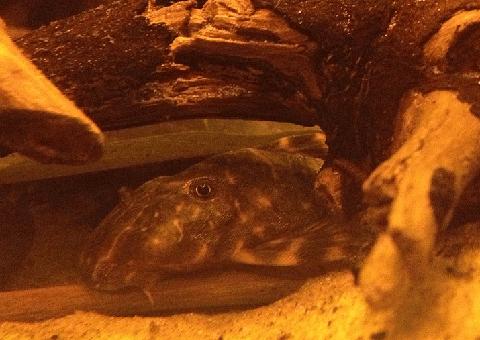
- Scientific name: Panaqolus maccus
- Difficulty: Easy
- Adult size: 3 – 5 inches
- Minimum tank size: 20 gallons
- Temperature: 73 – 82 °F
- Algae types: Biofilm on driftwood
Clown plecos are not as effective as bristlenose plecos or otocinclus catfish, but their small size and peaceful nature make them great algae eaters for betta aquariums in the 20-gallon range.
These fish are helpful algae eaters that can effectively clean up a small aquarium, although they spend most of their time feeding on driftwood.
Others You Think Might Work, But Don’t!
The recommended species mentioned above are not the only aquarium fish and invertebrates that feed on algae, so you might be wondering why some of the other algae eaters didn’t make the list. Read on to learn why these seven species don’t make good betta fish tank mates.
1. Guppies and Endlers Livebearers

Keeping guppies with your betta fish can be pretty risky, especially if you have colorful male guppies with big flowing fins. Their similar appearance may trigger some aggressive responses from your betta, but guppies are also known to nip betta fins.
Guppies will feed on algae, although they don’t eat quite enough to keep a tank clean.
2. Platies
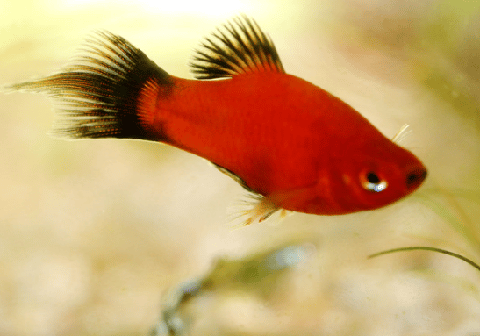
Platies are beautiful freshwater fish that can actually make good tank mates for your betta fish. Like guppies, these colorful livebearers are known to nip betta fins from time to time, but the main reason to avoid these active fish is their diet.
Platies can be good algae eaters, but they just aren’t as effective as something like an otocinclus catfish or a nerite snail.
3. Most Plecos
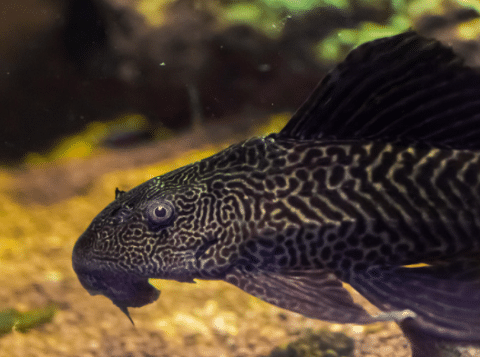
Plecostomus catfish are efficient algae eaters, although their size often turns into a problem. Most plecostomus catfish are simply too large to keep in a betta aquarium. Species like the common pleco can reach two feet in length, so adults require an aquarium that holds hundreds of gallons!
Stick to the bristlenose and clown plecos unless you keep your betta fish in a very large community tank.
4. Amano Shrimp

Amano shrimp are one of the best algae eaters for planted freshwater aquariums but they are not the best tank mates for a betta fish.
Unfortunately, betta fish tend to nip at these gentle crustaceans and they may even eat smaller specimens. Some betta fish will get along great with amano shrimp, but it’s just not worth the risk.
5. Cherry Shrimp

Adding cherry shrimp to your betta fish tank is probably not going to end well. Betta fish will eat these miniature invertebrates if they can catch them, so it’s really just a matter of time before these colorful shrimp disappear into your betta’s belly.
Unfortunately, the same goes for other shrimp species like ghost shrimp and young bamboo shrimp. If you would like to attempt keeping shrimp with your betta fish, my recommendation would be to start with a few ghost shrimp or feeder shrimp and see how your fish responds.
6. Siamese Algae Eater

Siamese algae eaters (SAEs) are avid algae eaters, but you should think twice before adding these active Asian fish to your betta tank.
Siamese algae eaters grow to 6 inches and they should always be kept in schools, so they need a much bigger aquarium than your average betta fish tank. Siamese Algae eaters also tend to stop eating algae as they mature, and they can get a little aggressive around feeding times.
7. Chinese Algae Eaters

The Chinese algae eater is not a smart choice for your betta tank because these freshwater fish can grow to over 10 inches in length and need a tank of at least 55 gallons for long-term care.
Even if you do keep your betta in such a spacious aquarium, there are more efficient and peaceful options for algae control.
Cleaner Fish
Some cleaner fish make great additions to a betta tank, although these helpful bottom feeders are not going to help with your algae problem. Many beginner aquarists assume that bottom feeders eat algae or that they do not need to be fed, but that’s not exactly true.
Cleaner fish will happily snack on any uneaten betta food that sinks to the bottom, although you’ll still need to feed them a healthy diet. The following cleaner fish can make great tank mates for your betta fish, just don’t expect them to do much about the algae.
1. Corydoras Catfish
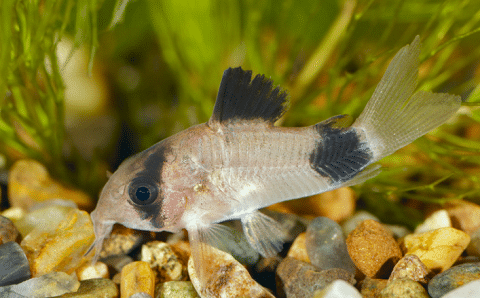
- Scientific name: Corydoras spp.
- Difficulty: Easy
- Adult size: 1 – 3 inches (depending on species)
- Minimum tank size: 30 gallons for most species
- Temperature: 72 – 78 °F
- Diet: Omnivorous. Provide a sinking food such as a bottom-feeder tablet
Corydoras catfish, also known as cories, are gentle bottom dwellers that make great tankmates for betta fish. These schooling fish love to hang out at the bottom of the tank and search through the substrate for tasty morsels.
Cory catfish are social creatures, so it’s important to buy a school of 5 or more of the same species. Smaller cories are a better fit for most betta aquariums, but keep in mind that the smallest species (dwarf and pygmy cories) tend to hang out in the water column or on plant surfaces more than the bottom of the tank.
2. Kuhli Loach
Kuhli Loaches are hardy bottom-dwelling fish. Nocturnal in nature. Gets along with many fish and tolerate of coldwater environments
- Scientific name: Pangio kuhlii
- Difficulty: Easy
- Adult size: 3 – 4 inches
- Minimum tank size: 20 gallons
- Temperature: 73 – 86 °F
- Diet: Omnivorous. Provide a sinking food such as a bottom-feeder tablet
Kuhli loaches are small, eel-like bottom dwellers that will search the substrate of your betta tank for uneaten food. These peaceful fish are mostly nocturnal, so you might not see them too much during the day.
Kuhli loaches are social fish, so you’ll need a small group of four or more. They will burrow into the sand or gravel of your tank, but be sure to add some hiding places like driftwood and rocks to help them feel secure during the day.
3. Whiptail catfish
- Scientific name: Farlowella spp.
- Difficulty: Moderate
- Adult size: 4 – 6 inches
- Minimum tank size: 20 gallons
- Temperature: 72 – 79 °F
- Diet: Sinking foods and algae
The whiptail catfish is one of the strangest freshwater fish species, but also one of the most peaceful. These camouflaged fish look just like a twig, which helps them stay hidden from predators in the wild.
Whiptail catfish are actually good algae eaters in their own right, although you’ll need to supplement their diet with sinking foods like tablets and wafers.
Other Techniques for Controlling Growth
Algae eaters can be extremely helpful for cleaning up your betta aquarium, although they are not the only option. Serious algae growth is usually a symptom of an imbalance of light and nutrients and there are a few steps you can take to control this pesky stuff if you have an aggressive betta that doesn’t want to share their tank.
Try these four techniques for controlling algae growth:
1. Cut the lights
Algae tend to thrive in high-light situations, especially if there are plenty of nutrients in the water. Make sure your betta tank is not exposed to any direct sunlight.
Powerful aquarium lights will also benefit algae, so use a timer to maintain a regular lighting schedule of about 6 hours or so each day.
2. Grow Live Plants

Live plants look great and create and healthy home for your betta fish. However, their true benefit lies in their algae-fighting abilities!
Healthy live plants effectively compete with algae and help to soak up excess nutrients in the water, so growing a few fast-growing stem plants can really help with persistent algae problems. However, dead plant matter actually decreases water quality, so take good care of your plants and fertilize them regularly.
3. More Maintenance
Poor water quality with high nitrate levels is a common cause of algae blooms. Test your tank water and perform regular water changes to keep your nitrate levels down to 20 parts per million or less.
You can also clean and remove algae manually during your maintenance routine. Grab your algae scraper and clean the glass before sucking water out of the tank with your gravel vacuum. A toothbrush works great for cleaning ornaments, rocks, and driftwood.
4. Reduce Feeding
Excess nutrients from over-feeding fish is one of the leading causes of poor water quality and excessive algae growth. Feed your betta fish once or twice a day and watch to see that your pet is finishing all the food. Uneaten pellets or granules that sink to the bottom will go to waste and increase nitrate and phosphate levels.
Can you have an algae eater with a betta?
There are many good algae eaters in the hobby that can live with betta fish, although it’s important to select a species that will be happy in your aquarium. Most algae-eating fish need a tank of at least 20 gallons, so snails may be the best choice if you have a small tank.
How do I get rid of algae in my betta tank?
Algae eaters are a great way to manage excess algae, although you can also remove algae manually when cleaning your tank.
Film algae can be removed from the tank glass with an algae scraper, while soft algae on the substrate can be sucked out with your gravel vacuum. Remove tougher algae on your hardscape with a small brush.
What is the best bottom feeder for a betta fish tank?
Corydoras catfish and kuhli loaches are some of my favorite bottom dwellers for large betta fish tanks. Malaysian trumpet snails are a good option for small tanks, although many aquarists prefer to avoid these inverts as they tend to multiply fast in nutrient-rich environments.
Can you put a betta with a plecostomus?
Plecos are good algae-eating fish for larger betta aquariums, although it’s important to choose the right species. Smaller species like the bristlenose and clown plecos are ideal for tanks of 30 gallons or more. Avoid larger varieties like the common pleco and sailfin pleco unless you have a very large fish tank.
How do I control algae in my betta tank?
Excess light and nutrients are common causes of algae, so make sure you aren’t feeding your fish too much, and avoid positioning your tank in direct sunlight or leaving your tank lights on all day. Good filtration, frequent maintenance, and regular water changes are also vital for keeping a clean tank.
Final Thoughts
Algae eaters and bottom dwelling fish are fascinating creatures that can help to keep your betta aquarium looking cleaner for longer. However, you should take your time before choosing your betta clean-up crew and make sure each species will live happily in your tank size and water parameters.
Have you kept algae eaters in your betta fish aquarium? Share your favorite species in the comments below!
- About the Author
- Latest Posts
I’m thrilled that you found Aquarium Store Depot! Here you’ll find information on fish, aquariums, and all things aquatics related. I’m a hobbyist (being doing this since I was 11) and here to help other hobbyists thrive with their aquariums! I adhere to a high quality Editorial Process and Review products with real life field usage and practical analysis.


